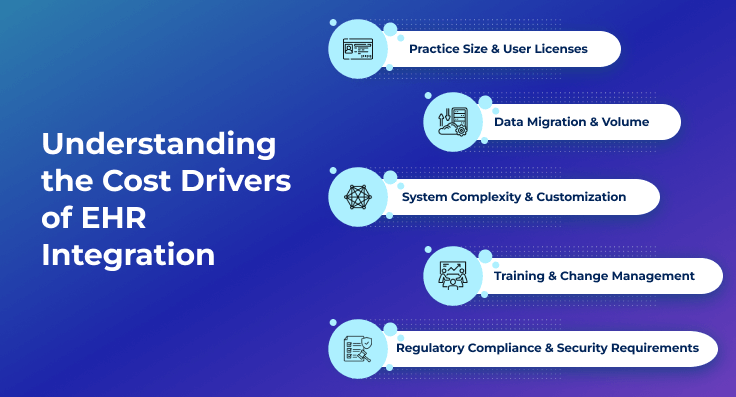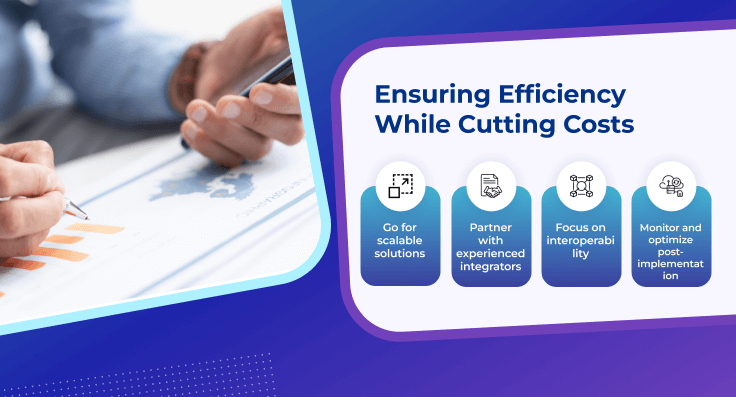Is the price tag of EHR integration something that you struggle with? Well, you’re not alone. According to recent data, EHR integration costs usually range from $30,000 to $50,000 or even more. This substantial investment creates a real problem for healthcare organizations who are struggling to fit within their budgets while ensuring the quality of their care.
In practice, there are many factors that determine the EHR integration pricing, such as practice size, system complexity, and specific data migration requirements. However, what many healthcare providers don’t recognize at first glance are hidden costs (which turn into inefficiencies, compliance issues, and ongoing maintenance) that can soon escalate the total investment far above the original number.
The good news? With strategic planning, you can reduce your EHR implementation cost to a great extent without sacrificing system performance or patient care quality. The approach to EHR integration can be made affordable rather than a financial burden. At OSP, we have assisted many healthcare organizations in their journey to integrate EHR at minimal cost. Now, let’s take a look into what exactly makes EHR integration costs increase and what we can do to avoid overspending whilst maintaining operational excellence.
EHR Integration Costs Breakdown- The Cost Drivers

Before we get into cost-saving strategies, it’s essential to understand what makes EHR implementation so expensive. Here are the main factors:
⦿ Practice Size & User Licenses
The math here is straightforward. Big practice means more user licenses. Licensing fees alone are $100 to $500 per provider per month, and enterprise-level solutions cost even more. This ongoing expense forms a significant portion of your EHR integration cost breakdown.
⦿ System Complexity & Customization
Although off-the-shelf EHR solutions are often less expensive, they rarely meet a healthcare organization’s specific needs. Many practices need custom features like tailored workflows or advanced reporting. Customization pays off in the long run but can add upfront costs of implementing EHR and extend implementation timelines.
⦿ Data Migration & Volume
EHR Migration patient records is a big expense, typically $20,000 to $50,000, depending on the volume of data. Practices with much historical patient data will face higher EHR integration costs due to the time and resources required for a smooth transition.
⦿ Training & Change Management
Training staff on a new EHR system can cost $1,000 to $5,000 per employee. Without proper training, you’ll face inefficiencies and errors, which will add to the EHR integration maintenance expenses.
⦿ Regulatory Compliance & Security Requirements
Compliance with standards like HIPAA compliant , HL7 integration, and FHIR adds to the overall cost of EHR implementation in hospitals. Practices need to invest in security audits and legal reviews. Non-compliance can result in penalties, breaches, and costly system modifications down the road.
Strategies to Reduce EHR Pricing Without Losing Efficiency

Now that we know what drives our costs let’s look at how we can reduce your EHR integration costs without sacrificing system performance:
1. Choose the Right EHR
Choosing the right EHR is key. Go for interoperable EHRs with built-in features to reduce the need for customizations. For example, cloud EHRs come with pre-configured medical billing, lab information systems, and telehealth integrations, so you can save time and money.
2. Prioritize Data Migration Planning
Data migration is a big expense, but you can reduce costs by migrating only the essential data rather than all legacy records. Healthcare Automation tools can also speed up the process and reduce manual labor and errors.
3. Invest in Cost-effective Training Programs
Training doesn’t have to be expensive. Go for self-paced e-learning modules instead of on-site training sessions. You can also train a few “superusers” who can then assist other staff members so you don’t have to rely on external trainers. These approaches can dramatically reduce your EHR implementation costs while ensuring staff competency.
4. Use API-Based and Pre-Built Integrations
Custom-built solutions cost 30-50% more. However, API-based integrations are more cost-effective than custom software development. Pre-built integrations for common workflows can significantly reduce your EHR integration pricing while accelerating implementation.
5. Use Cloud-Based EHRs to Save Infrastructure Costs
On-premise systems require expensive hardware, dedicated IT support, and maintenance. Cloud-based EHRs eliminate upfront costs, scale better, and auto-update. This approach is affordable and dramatically reduces long-term EHR integration maintenance costs.
6. Stay Compliant from the Start
Retrofitting compliance later can cost far more than building it in. Partner with EHR integration specialists to ensure your system is compliant before starting. This proactive approach prevents costly modifications and potential penalties that would increase your overall cost of EHR implementation.
4. Ensuring Efficiency While Cutting Costs

Reducing costs is important but not at the expense of efficiency. Here’s how to transition smoothly while optimizing your budget:
⦿ Go for scalable solutions
As your practice grows, so should your EHR system. Choosing scalable systems means no costly upgrades down the road, making your EHR integration costs more predictable over time.
⦿ Partner with experienced integrators
Work with healthcare IT experts and folks who know technical requirements and clinical workflow to ensure a smooth integration process. This saves you from disruptions, delays, and discomfort.
⦿ Focus on interoperability
Make sure your EHR system integrates well with other tools and platforms to reduce inefficiencies and improve overall workflow. Reduced friction between systems leads to lower lifetime costs of implementing EHR in interoperable systems.
⦿ Monitor and optimize post-implementation
Track system performance and gather user feedback to identify areas for improvement. Taking a proactive approach ensures your EHR remains cost-effective and efficient.
Wrapping Up
EHR integration shouldn’t suck up your organization’s financial resources. By recognizing the most important cost drivers of integration and using strategic approaches to EHR integration costs, healthcare providers can achieve efficiency and compliance without excessive costs.
The secret is finding the proper balance between saving cash now and making your operations more efficient over time. This balanced approach yields dividends for decades after installation, making your EHR implementation costs pay maximum value over time.
The post How to Reduce EHR Integration Costs Without Compromising Efficiency appeared first on Osplabs.





